What is a Timesheet? Uses, Types, and Benefits

A timesheet is a comprehensive record-keeping mechanism that tracks the hours employees dedicate to various tasks and projects.
Understanding the pivotal role of timesheets requires an appreciation of their importance in optimizing productivity and resource allocation.
Small business owners, in particular, grapple with multifaceted challenges, and timesheets emerge as a powerful solution to address these critical issues.
From streamlining payroll processes to enhancing project management and fostering accountability, timesheets capture hours worked and provide invaluable insights into operational efficiency.
Top three issues that time sheets solve for small business owners are:
1. Accurate Payroll Processing
Small business owners often face challenges in tracking work hours and calculating payroll.
Timesheets provide a systematic and transparent method for recording the time spent on various tasks, minimizing errors in wage calculations.
2. Project Management and Resource Allocation
Timesheets offer a granular view of how employees allocate their time across different projects.
By clearly understanding where time is being invested, small business owners can make informed decisions, prioritize tasks, and strategically allocate resources for maximum productivity.
3. Employee Accountability and Performance Evaluation
Establishing a culture of accountability is essential for the success of any business.
Timesheets are tangible records of an employee’s activities, fostering accountability and transparency.
Small business owners can use timesheet data to assess individual and team performance, identify areas for improvement, and recognize high performers.
Try Buddy Punch For Free
What is a Timesheet?
A timesheet is a structured document that tracks and records employees’ time on various tasks and projects within a specific timeframe.
As a fundamental component of time management, timesheets facilitate the meticulous documentation of work hours, providing businesses with a comprehensive overview of labour allocation.
Typically organized in a table format, timesheets include columns for date, task description, and hours worked, enabling employees and employers to monitor and analyze time-related data.
What is a Timesheet Software?
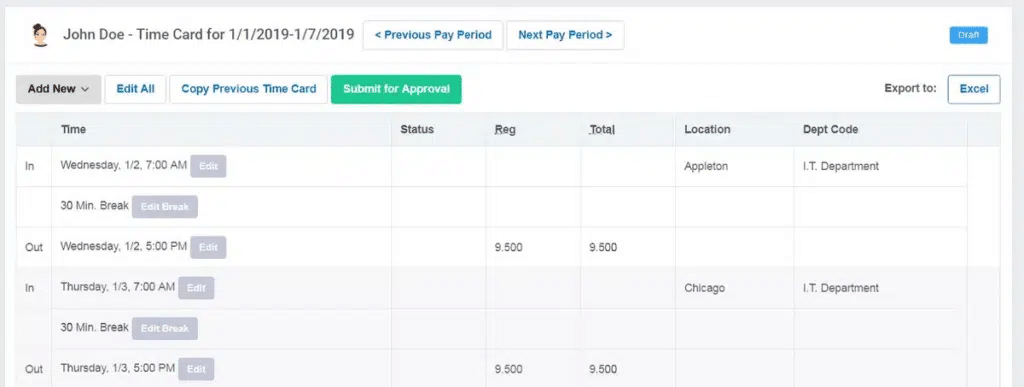
Timesheet software is a digital tool designed to streamline the tracking and managing employee work hours and tasks.
Timesheet apps automates timekeeping, replacing traditional manual methods with efficient and accurate digital recording.
Following are the levels on which timesheet software is usually used:
- Employees
- Employers
- HR Department (Human Resources)
| User Level | Employees | Employers | HR |
| Usage | Easily log and submit daily work hours, facilitating precise time tracking for tasks and projects. | Access real-time data on employee work hours and project progress, aiding in resource allocation and project management. | Streamline payroll processes, monitor workforce efficiency, and generate comprehensive reports for performance analysis and compliance. |
| Benefits | Convenient and accurate time tracking, reducing errors in payroll and ensuring fair compensation. | Enhanced project management, optimized resource allocation, and improved decision-making based on real-time data. | Efficient payroll processing, performance evaluation, and compliance management, leading to better HR operations and strategic workforce planning. |
How Does a Timesheet Work?
The timesheet process begins with individuals logging their daily tasks and corresponding time spent on a designated timesheet, whether punch cards or digital platforms.
Employees record time by indicating the start time, end times, and the amount of time dedicated to each task throughout the workday.
This can be done manually on paper-based timesheets or using online timesheets for a more streamlined approach.
Employers and project managers play a crucial role in overseeing the timesheets record.
They review entries, track time, and validate the number of hours logged by team members.
This meticulous approach ensures the accuracy and completeness of the recorded hours, reducing the risk of errors in calculating total hours worked and overtime hours.
The use of spreadsheets or project timesheets facilitates efficient tracking and management of employee performance.
In addition to minimizing human error, these systems often integrate with project management tools, providing real-time insights into task progress and resource allocation.
Such integration allows for a comprehensive overview of the amount of time spent on various projects and tasks.
The collaborative nature of a well-functioning timesheet system fosters transparent communication between employees and management, creating a foundation for informed decision-making within the organizational framework.
Digital Vs. Paper Timesheets
In the age of technological advancement, the debate between digital and paper timesheets continues to shape how businesses manage their timekeeping processes.
Here’s a concise comparison.
| Aspect | Digital Timesheets | Paper Timesheets |
| Accuracy & Errors | Automate calculations, minimizing human errors. | Prone to manual miscalculations and transcription errors. |
| Accessibility | Accessible anytime, anywhere with internet connectivity. | Limited accessibility, often confined to the workplace. |
| Efficiency | Streamlined data entry and real-time tracking enhance efficiency. | Tedious manual entry may lead to delays and inefficiencies. |
| Environmental Impact | Environmentally friendly, reducing paper usage. | Involves paper consumption, contributing to environmental impact. |
| Cost | Initial setup costs, but potential long-term savings through efficiency. | Lower initial costs but may incur hidden expenses over time. |
Ready to give Buddy Punch a try?
For free trial, no credit card required.
Why Should a Business Use Timesheets?
Timesheets provide a structured framework for tracking employee work hours, offering a multitude of benefits that significantly impact organizational efficiency.
- Timesheets are instrumental in inaccurate payroll processing, ensuring fair compensation and minimizing errors.
- They empower businesses to enhance project management by providing insights into resource allocation and task progression.
- Timesheets cultivate a culture of accountability among employees, fostering transparency and aiding performance evaluation.
What Features Should Be Looked For in a Simple Timesheet Software? Buying Guide
Following are some of the essential features to look for in simple timesheet software.
1. Easy Time Tracking Through Different Devices
The ability of a timesheet app to facilitate easy time tracking across various devices is a pivotal consideration.
The time tracking software should offer diverse options, such as a mobile app (Android and iOS), desktop app (Windows and Mac), and even a text-to-punch feature.
With compatibility across smartphones, tablets, and computers, these features ensure seamless time tracking regardless of device preference or connectivity.
Whether through facial recognition, QR codes, or a four-digit PIN, the time tracking tool should provide a user-friendly experience, allowing employees to clock in and out effortlessly.
2. Filters
When considering timesheet software for your business, the presence of robust filtering options is a crucial factor to assess.
With features such as job codes, locations, and customizable reports, businesses can efficiently organize and retrieve time-related information.
The ability to filter based on employee, project, or specific timeframes empowers users to streamline payroll processes, track project progress, and assess individual performance.
3. Automated Timesheet Approval Process
The significance of an efficient automated timesheet approval process cannot be overstated.
As businesses transition from traditional paper-based methods to digital solutions, the automation of timesheet approvals emerges as a critical feature.
Employees should be able to submit digital time cards at the end of each pay period, enabling project managers and administrators to swiftly review, approve, or reject entries with a simple click.
This transparent system facilitates seamless approvals and allows for comments and feedback, fostering effective communication between management and staff.
By automating the timesheet approval process, businesses ensure accuracy, compliance with labour laws, and a comprehensive view of each employee’s work week for efficient task allocation and resource management.
4. Timesheet Reminders
Prioritizing effective timesheet reminders is crucial.
Utilizing diverse communication channels like email, text messages, and push notifications enhances user engagement.
Email notifications offer a traditional yet reliable means of alerting users to timesheet-related tasks.
Text messages provide a direct and immediate communication channel, ensuring timely responses.
Leveraging push notifications adds a modern touch, delivering real-time reminders to users and fostering a proactive approach towards timesheet management.
Integrating these reminder features ensures seamless communication and encourages timely and accurate timesheet submissions, contributing to efficient workforce management.
5. Integrations
When considering a timesheet software, evaluating its integrations is vital.
The ability to seamlessly connect with other tools enhances the software’s functionality.
Buddy Punch’s time clock software integrates with various accounting systems such as QuickBooks, Paychex, Gusto, and more.
This ensures a smooth flow of data between time tracking and payroll processes.
The integration feature reduces manual errors and accelerates timesheet approvals, contributing to increased productivity.
A well-integrated system like Buddy Punch offers streamlined data transfer, efficient time tracking, and improved reporting capabilities, making it a valuable asset for businesses seeking comprehensive workforce management solutions.
6. Payroll Period
Integrating with Buddy Punch ensures a seamless transition from time tracking to payroll.
The software offers diverse pay period options, including weekly, bi-weekly, semi-monthly, and monthly cycles.
This flexibility caters to various business needs, allowing customization based on employee preferences and operational requirements.
Accurate payroll processing is simplified with Buddy Punch’s built-in payroll functions, offering unlimited payroll runs, integrated timesheets, automated payments, and more.
As you explore timesheet solutions, prioritize features that align with your payroll structure for a comprehensive and practical workforce management experience.
7. Timesheet Reports
Timesheet reports are crucial in providing insights into employee productivity and project timelines.
These reports facilitate better project management, aiding in budgeting, invoicing, and payroll processes.
For a seamless and insightful experience, prioritize timesheet software that excels in generating detailed and customizable reports aligning with the specific needs of your business.
How Does Buddy Punch Timesheet Software Prove To Be An Efficient Choice?
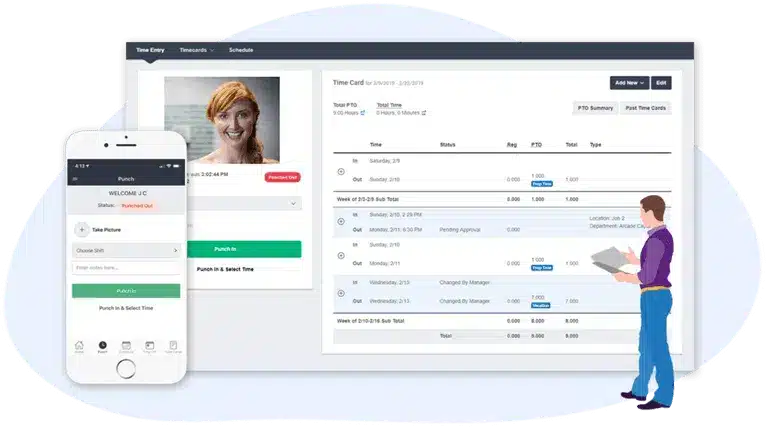
Buddy Punch is an unparalleled choice for small businesses in timesheet software, offering a comprehensive solution that seamlessly combines efficiency and affordability.
Unlike other tools, Buddy Punch excels in traditional time tracking and goes above and beyond with a range of advanced features crucial for small business operations.
One standout feature is the trio of GPS location tracking, geofencing, and facial recognition.
These functionalities collectively combat time theft, ensuring employees are where they should be during work hours, on-site or in the field.
The customizable reports generated by Buddy Punch provide a detailed overview of employee activities, including clock in/out times, PTO taken, and work hours.
Another distinctive aspect is the option for timesheet approvals.
Whether you prefer monthly, bi-weekly, or weekly timesheets, Buddy Punch allows administrators to review entries before approval, ensuring accuracy in recorded hours.
The tool adapts to the specific needs of small businesses, recognizing the importance of flexibility and customization.
The software’s compatibility across various devices, including smartphones, desktops, and tablets, further underscores its versatility and accessibility, making it the ideal choice for small businesses looking to elevate their time tracking processes.
1. GPS Tracking
With real-time GPS coordinates, employers can monitor employees’ clock-ins and clock-outs, ensuring accuracy and location verification.
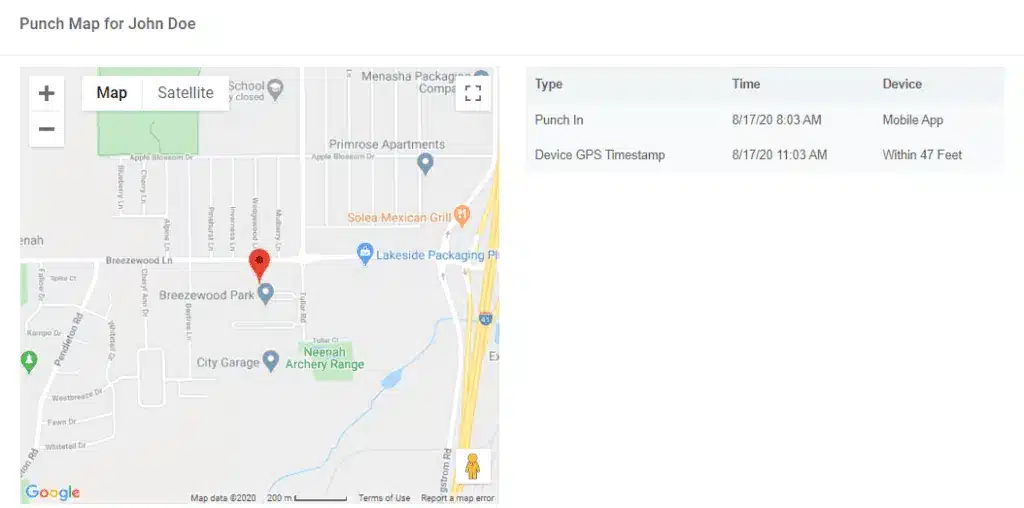
The GPS feature provides an interactive map, allowing individual punch-ins and an overall view of all employee locations.
2. QR Code Scanning
With QR Codes, employees can seamlessly clock in and out by scanning a code with their smartphones or tablets.
This advanced method eliminates the need for traditional usernames and passwords, ensuring swift and accurate time tracking.
The QR Code feature enhances the attendance system, allowing real-time monitoring of employee locations and enabling self-reporting.
Employers can leverage the information embedded in QR Codes, such as timestamps and GPS locations, for automatic attendance records.
3. IP Address Locks
With IP Address Locks, employers can ensure that employees punch in or out only from designated devices or locations, enhancing control over remote work scenarios.
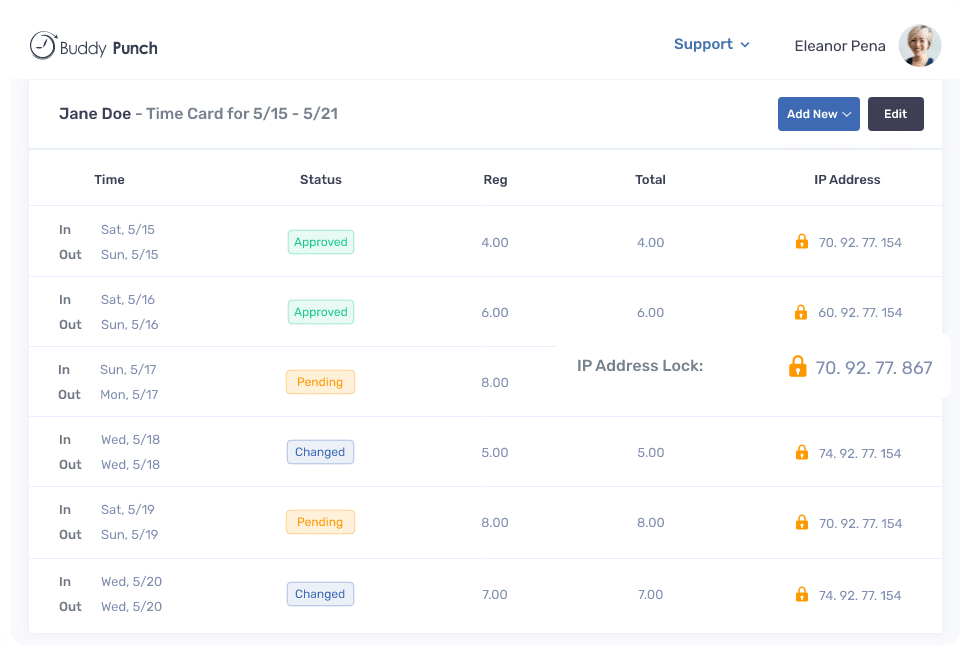
This feature allows administrators to create specific IP Address Locks, specifying the locations or devices where employees can log their hours.
This added layer of security is particularly beneficial for businesses with remote teams, as it prevents unauthorized access and provides transparency in tracking employee work hours.
4. Facial Recognition
By utilizing facial recognition, businesses can virtually eradicate unauthorized time entries, ensuring accurate and reliable attendance records.
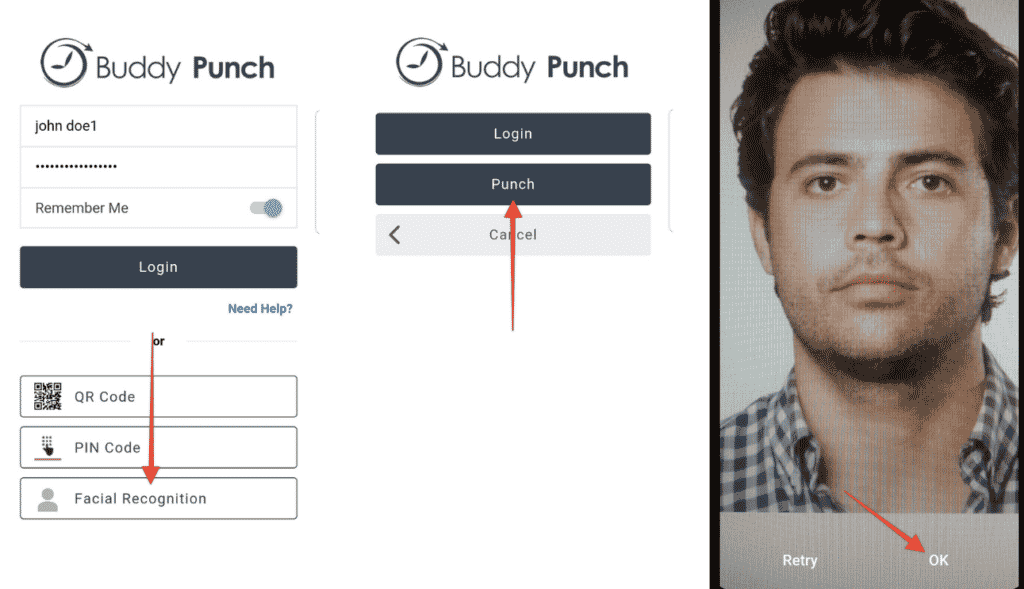
The system captures images for each punch, visually verifying employees’ presence and simplifying the review process for administrators.
5. Device Compatibility
The Buddy Punch timesheet apps are designed to work effortlessly on smartphones, desktops, and tablets, offering users flexibility in choosing their preferred device for time management.
Moreover, Buddy Punch is compatible with major operating systems, including iOS, Android, Windows, and Mac.
Whether on the go with your smartphone or working from a desktop or tablet, Buddy Punch provides a consistent and user-friendly experience, making it a versatile solution for adequate time tracking across diverse devices and platforms.
6. Customizable Reports
The Buddy Punch timesheet system allows seamless reports to export in versatile formats such as Excel, CSV or Adobe PDFs, providing flexibility for diverse business needs.

With these export options, users can easily integrate timesheet data into their existing workflows or share comprehensive reports with stakeholders.
The reports offer a detailed overview of employees’ activities, enabling businesses to gain insights into their workforce’s productivity and time allocation.
7. Timesheet Approvals
This functionality offers meticulous review and approval options, ensuring accuracy in employee time entries.
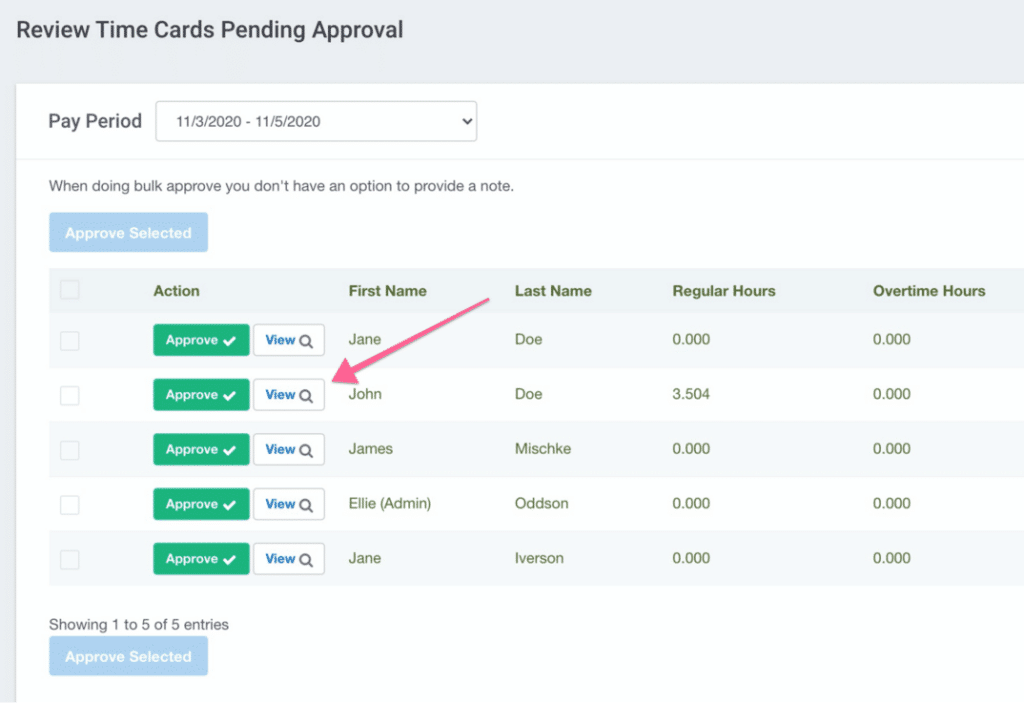
Whether your payroll cycle is monthly, bi-weekly, or weekly, Buddy Punch accommodates diverse needs.
Managers and administrators can seamlessly navigate through timesheets, making necessary adjustments and providing comments.
The system offers a comprehensive overview of employee work hours, streamlining the approval process.
8. Error-Free Time Tracking
Buddy Punch timesheet software ensures precise and efficient time tracking.
By replacing manual timesheets with automated solutions, the software minimizes the risk of human errors, ensuring accurate and reliable data.
This transition enhances the overall integrity of reports, providing a detailed overview of employee activities.
Moreover, the system’s automation eliminates unpaid hours, guaranteeing that every worked hour is accounted for in payroll calculations.
This streamlines the payroll process and contributes to fair compensation, boosting employee satisfaction and compliance with labour regulations.
9. User-Friendly Interface
The Buddy Punch’s platform’s design prioritizes simplicity without compromising functionality, making it easy for users to navigate and accomplish tasks.
The user-friendly interface facilitates smooth clock-ins, clock-outs, and timesheet management, increasing employee engagement and productivity.
With straightforward features and clear navigation, Buddy Punch promotes accessibility across various devices, allowing users to track and manage their work hours effortlessly.
The emphasis on a user-friendly interface enhances the overall usability of the software, making it an ideal solution for businesses seeking a reliable and easy-to-use time-tracking system.
10. Integration with Business Processes
The software minimises data entry errors by connecting with accounting tools such as QuickBooks Excel and popular payroll services like ADP Workforce Now and Gusto.
It accelerates the approval of timesheets and PTO.

This integration ensures a more convenient method for employees to input and approve time-tracking data, enhancing overall efficiency.
The system’s compatibility with Zapier extends its adaptability to over a thousand websites and apps, facilitating a cohesive approach to time management, reporting, and business analytics across diverse platforms.
Buddy Punch’s Online Reviews

“The ease of clocking in and out, where ever I may need to punch in. I like that employees are able to make an adjustment to their time and then it gets approved by manager. Which is much easier than having to make punches and delete punches.”
Click here to read the full review.
“It is very feasible and easy to use. As an employee, I can easily check my attendance sheet. It does need for me to click other features to be able to access it.”
Click here to read the full review.
“About being able to monitor my schedule and use buddy punch as time clock for my work. It really helps me in checking weekly schedules.”
Click here to read the full review.
Try Buddy Punch for Free
Ready to give Buddy Punch a try?
For free trial, no credit card required.
If you feel that Buddy Punch might fit your business, sign up for a 14-day free trial (no credit card needed). You can also book a one-on-one demo or view a pre-recorded demo video.
Why Are Timesheets Important For The Payroll System?
Timesheets play a crucial role in the payroll system for several reasons.
Firstly, they serve as detailed records of employees’ worked hours, providing accurate data for payroll processing.
Timesheets ensure fair compensation by documenting regular hours, overtime, and other relevant details.
Moreover, timesheets contribute to compliance by demonstrating adherence to labour laws and regulations, mitigating business legal risks.
Automated timesheet systems, like those offered by Buddy Punch, further enhance payroll efficiency by reducing errors associated with manual tracking.
The precision and transparency of timesheets not only streamline payroll processes but also foster trust between employers and employees, promoting a fair and accountable compensation system.
Ready to start a free trial?
No credit card required, all features included.
What Are The Applications Of Timesheets?
Following are some of the few applications of timesheets.
1. Payroll Processing
Timesheets are the foundation for calculating employee wages ensuring accurate and transparent compensation.
By meticulously recording hours worked, including regular time and overtime, timesheets provide a reliable basis for payroll calculations.
2. Service Based Industries
In service-based industries, timesheets are critical for operational efficiency and financial accuracy.
These industries, encompassing consulting, IT, or professional services, rely heavily on accurate time tracking for client billing and project management.
Timesheets in service-based settings document the hours spent on specific client projects, enabling businesses to invoice clients accurately based on the time invested.
This level of precision enhances transparency in client interactions and ensures that services rendered align with billed hours.
Additionally, timesheets aid in resource allocation, allowing businesses to optimize workforce distribution across various projects.
The systematic use of timesheets in service-based industries enhances accountability, supports effective project management, and contributes to the overall success of client engagements.
3. Law Office
In a law office, timesheets are indispensable tools for managing billable hours, client invoicing, and overall operational efficiency.
Attorneys and legal professionals meticulously track their time on different cases and tasks, ensuring accurate client billing.
Timesheets provide a detailed breakdown of activities, allowing law firms to justify charges, demonstrate work performed, and maintain transparency in client relationships.
Moreover, timesheets aid in project management, helping law offices allocate resources effectively and assess the productivity of their legal teams.
They contribute to strategic decision-making by offering insights into the profitability of specific cases or practice areas.
Using timesheets, law offices streamline their payroll processes, enhance billing accuracy, and uphold ethical standards in legal billing practices.
4. Healthcare
In healthcare, timesheets are critical in optimizing patient care, resource management, and compliance.
Healthcare professionals, including doctors, nurses, and support staff, use timesheets to record their work hours accurately.
This precise tracking ensures compliance with labour regulations and provides fair compensation for their valuable services.
Timesheets facilitate efficient scheduling of medical personnel, ensuring adequate coverage for different shifts and departments.
The detailed documentation of tasks and patient interactions helps healthcare providers analyze workflow patterns, identify areas for improvement, and enhance overall operational efficiency.
5. Construction
In the construction industry, timesheets are indispensable for managing workforce activities, project timelines, and overall project costs.
Construction projects involve diverse teams, including labourers, subcontractors, and project managers, each with unique roles and responsibilities.
Timesheets are instrumental in tracking the hours worked by construction personnel, ensuring accurate payroll processing and adherence to labour regulations.
They enable project managers to monitor the progress of tasks, allocate resources efficiently, and maintain optimal project timelines.
Real-time insights into labour costs aid in budget management and prevent cost overruns.
For construction companies bidding on projects, detailed timesheets provide valuable data for estimating future projects accurately.
Companies can refine their project proposals by analysing historical time data, leading to more competitive and profitable bids.
6. Educational
In the educational sector, timesheets are crucial in efficiently managing faculty and staff schedules, ensuring accurate payroll processing, and optimizing resource allocation.
Educational institutions, including schools and universities, rely on timesheets to track the hours worked by teachers, administrative staff, and other employees.
Timesheets help educational administrators monitor attendance, plan class schedules, and manage work hours effectively.
This level of tracking is precious for part-time or adjunct faculty members whose schedules may vary.
Educational organizations can streamline payroll processes and prevent discrepancies by accurately recording work hours.
7. IT industries
In IT industries, timesheets are invaluable tools for tracking and managing work hours, enhancing project management, and ensuring accurate billing processes.
IT professionals often work on diverse projects with varying timelines and deadlines, making precise time tracking crucial for project success.
Timesheets enable IT teams to log hours spent on specific tasks, projects, or client work.
This detailed tracking enhances project management by providing insights into resource allocation, identifying bottlenecks, and facilitating informed decision-making.
For IT businesses engaged in client services or project-based work, timesheets are pivotal in billing accuracy.
They provide a transparent record of billable hours, ensuring clients are accurately invoiced for the services rendered.
8. Small Businesses
Timesheets empower small business owners to monitor and manage work hours, ensuring optimal workforce utilization.
Accurate time tracking eliminates errors in wage calculations, ensuring that employees are compensated fairly for their work.
Implementing timesheets is a valuable strategy for small businesses aiming to enhance operational efficiency, maintain budgetary control, and foster a productive work environment.
Timesheets contribute to organizational growth by providing insights into workforce dynamics and facilitating informed decision-making for resource optimization.
Types Of Timesheets for Small Businesses
For small businesses, choosing the right type of timesheet is crucial for efficient time management and payroll processes.
1. Timesheets For Salaried Workers
Timesheets for salaried workers play a crucial role in small businesses, offering a structured method for tracking their contributions.
While salaried employees may not clock in and out traditionally, timesheets for this category provide a means to record their daily activities, projects, or tasks.
These timesheets focus on inputting work-related information, detailing allocating time to various responsibilities.
These timesheets for small businesses employing salaried workers contribute to project management, productivity analysis, and resource optimization.
By documenting tasks and projects, employers gain insights into the distribution of efforts across different areas, aiding in performance evaluations and future planning.
Additionally, timesheets for salaried workers foster transparency, aligning individual contributions with organizational objectives.
2. Daily Timesheets
Daily timesheets are a practical and straightforward method for tracking employee hours.
These timesheets capture the daily work hours of each employee, offering a detailed breakdown of tasks and projects undertaken within a given day.
Small businesses often find daily timesheets beneficial for monitoring short-term projects, client work, or tasks requiring close attention to time allocation.
The advantages of daily timesheets for small businesses include:
- Enhanced accuracy in tracking payroll hours.
- Improved project management.
- The ability to promptly identify any deviations from schedules.
This type of timesheet proves particularly valuable in dynamic work environments where tasks may vary day by day.
3. Weekly Timesheets

Weekly timesheets are a fundamental tool for small businesses to streamline their time-tracking processes.
These timesheets consolidate employee work hours weekly, offering a comprehensive overview of labour allocation and project timelines.
Small businesses often find weekly timesheets practical for regular payroll cycles and monitoring ongoing projects.
The benefits of utilizing weekly timesheets include:
- Simplified payroll processing.
- Improved accuracy in tracking overtime.
- The ability to assess labour distribution across various tasks.
Small companies can enhance operational efficiency by implementing weekly timesheets, ensuring compliance with labour regulations, and facilitating strategic decision-making based on a consolidated view of workforce efforts throughout the week.
4. Bi-Weekly Timesheets
Bi-weekly timesheets are a valuable timekeeping solution for small businesses, offering a structured approach to tracking employee hours over two weeks.
This type of timesheet aligns with bi-weekly payroll cycles, making it a practical choice for businesses that process payroll every two weeks.
Small businesses often appreciate the simplicity and regularity of bi-weekly timesheets, as they align with standard payroll practices.
Employees can easily record their hours worked, including overtime or special projects, contributing to precise compensation and project cost analysis.
5. Monthly Timesheets
Monthly timesheets offer a streamlined time-tracking approach for small businesses that operate on a monthly payroll cycle.
These timesheets cover an entire month, making them suitable for companies that prefer a less frequent payroll processing schedule.
Employees can efficiently record their daily work hours, project details, and any additional monthly notes.
The monthly timesheet structure simplifies timekeeping for both employees and employers.
It provides a comprehensive overview of labour hours, aiding in accurate payroll calculations and budget forecasting.
Small businesses often find monthly timesheets convenient for long-term project tracking, helping managers assess employee productivity and project timelines over the entire month.
With their straightforward format, monthly timesheets contribute to effective time management and financial planning for small businesses.
Try Buddy Punch For Free
What Are The Advantages Of Timesheets?
Following are a few benefits of using timesheets for your business.
1. Reduces Time Wastage

By implementing timesheets, businesses can streamline and optimize their time-tracking processes, minimizing the manual effort required for attendance monitoring, data entry, and payroll management.
The meticulous recording of work hours through timesheets contributes to increased efficiency in payroll processing, ensuring accuracy and reducing the risk of errors associated with manual time tracking.
This saves valuable administrative time and enhances overall productivity by allowing employees and management to focus on strategic tasks rather than being bogged down by time-related paperwork.
2. Bill Accurately
Timesheets provide a detailed and transparent account of the time spent on specific tasks or projects, allowing for precise billing based on actual hours worked.
This accuracy is particularly crucial for service-based industries, consultancy firms, or freelance professionals who bill clients based on hourly rates.
3. Automate your Payroll
By utilizing timesheets, businesses streamline the calculation of employee wages and eliminate the need for manual payroll computations.
Automated payroll systems, integrated with timesheets, accurately calculate working hours, overtime, and other relevant data, reducing the likelihood of errors associated with manual data entry.

Timesheet data seamlessly flows into payroll systems, ensuring employees are compensated accurately based on their recorded work hours.
This integration between timesheets and payroll increases efficiency and minimizes the risk of payroll discrepancies, contributing to improved financial accuracy and compliance with wage and hour regulations.
4. Improves Project Management
With timesheets, project managers gain insight into how much time is devoted to specific tasks, aiding in identifying potential bottlenecks or areas for improvement.
Timesheets contribute to improved project cost estimation by providing accurate data on labour hours expended.
This not only enhances budgeting accuracy but also aids in preventing cost overruns.
Furthermore, timesheets foster accountability and transparency within project teams, as each member’s contributions are documented.
This, in turn, promotes a culture of responsibility and aids in performance evaluation.
5. Save Money For Your Company
Timesheets enable organizations to identify productivity trends, allowing for informed decisions on staffing levels and workload distribution.
This data-driven approach aids in avoiding overstaffing or underutilization, ensuring that your company pays for the work performed.
Moreover, the visibility into project hours and tasks helps identify areas where efficiency can be improved, leading to potential cost savings.
By fostering accountability and transparency, timesheets contribute to a culture of responsible time management, ultimately translating into financial benefits for your company.
6. Improvising With Powerful Insights
By meticulously recording employee work hours and project timelines, timesheets become a gateway to a wealth of data that can inform critical business decisions.
The real-time visibility into workforce activities allows for proactive management strategies.
Employers can identify productivity patterns, allocate resources effectively, and address bottlenecks promptly.
These insights are instrumental in optimizing workflows, enhancing project management, and ensuring tasks are completed efficiently.
7. Improves Productivity
By systematically documenting employee work hours and tasks, timesheets provide a transparent overview of individual and team contributions, fostering a culture of accountability and efficiency.
One key advantage is identifying peak productivity periods and areas needing improvement.
With insight from timesheets, managers can optimize work schedules, ensuring tasks align with peak productivity hours.
This leads to a more streamlined and effective use of resources, ultimately boosting overall productivity.
8. Delegation and Automation
Timesheets offer significant advantages in delegation and automation, streamlining managerial processes and enhancing organizational efficiency.
Delegation becomes more effective as managers can easily assign tasks, track progress, and manage workloads based on real-time data from timesheets.
Ready to give Buddy Punch a try?
For free trial, no credit card required.
Why Do Businesses Use Timesheet Software?
Businesses utilize timesheet software for several compelling reasons.
1. Tracking Employee Productivity
Businesses leverage timesheet software primarily for tracking employee productivity.
This tool offers a systematic and automated approach to monitoring the time employees dedicate to various tasks, projects, or clients.
Businesses gain valuable insights into individual and team productivity levels by precisely recording work hours.
2. Complying With Labor Laws
Businesses utilize timesheet software for several reasons, and one critical aspect is ensuring compliance with labour laws.

Time tracking is essential for adhering to regulations governing employee work hours, overtime, and breaks.
Timesheet software provides a systematic and accurate method to record and manage employee working hours, aiding businesses in meeting legal requirements.
It helps track regular working hours and overtime, ensuring employees are compensated correctly and fairly.
Additionally, timesheet software assists in monitoring rest breaks and meal periods, helping businesses adhere to labour laws that mandate specific break durations.
Automated timesheet systems contribute to compliance by reducing the risk of errors or inaccuracies in manual record-keeping, which could lead to legal complications.
By maintaining precise records, businesses can demonstrate their commitment to labour law compliance, mitigate potential risks, and create a transparent and fair working environment for their employees.
3. Achieve Accurate Payroll
Businesses utilize timesheet software to achieve accurate payroll processing, a critical aspect of workforce management.
The software offers a systematic and automated approach to tracking employees’ work hours, ensuring precision in calculating wages and benefits.
Timesheet software streamlines the payroll process by eliminating manual data entry and reducing the likelihood of errors associated with traditional methods.
By automating payroll calculations, businesses can save time and resources that would otherwise be spent on manual payroll processing.
4. Analyze Qualifications
Businesses employ timesheet software for tracking hours worked and analyzing qualifications and skills within their workforce.
This feature allows companies to align the right talents with specific projects or tasks, optimizing resource allocation and project management.
By integrating qualifications analysis into timesheet software, businesses can quickly assess employees’ skill sets and experiences.
This information proves valuable when assigning roles or projects, ensuring that individuals with the most relevant expertise are selected. This capability enhances workforce planning and decision-making processes.
Moreover, the software facilitates the identification of training needs and skill gaps, enabling businesses to invest in targeted professional development programs.
This strategic approach to workforce management contributes to employee growth, job satisfaction, and overall organizational success.
5. Build A Historical Database
Businesses utilize timesheet software to build a comprehensive historical database as a valuable resource for strategic decision-making and future planning.
This software allows organizations to accumulate detailed records of employee working hours, project timelines, and task completion rates over time.
By creating a historical database through timesheet software, businesses gain insights into past performance, enabling them to identify trends, patterns, and areas for improvement.
6. Improve Estimates
Businesses leverage timesheet software to enhance their ability to estimate project timelines and resource requirements accurately.
The software provides a systematic and data-driven approach to tracking employee work hours, project progress, and task completion.
By capturing real-time data on the time spent on various tasks and projects, businesses can compare it with initial estimates.
This information allows for a more precise evaluation of how long specific activities take, enabling teams to refine their future project estimates.
Improved estimates contribute to better planning, resource allocation, and budget management.
How Do You Make Your Employees Fill Up The Timesheet?
Encouraging employees to fill out timesheets consistently is crucial for accurate time tracking and efficient business operations.
Implementing a few strategies can streamline the process and ensure widespread compliance.
Firstly, communicate the importance of timesheets in project management, payroll accuracy, and overall business efficiency.
Make employees aware of how diligent time tracking contributes to the organization’s success.
Simplify the timesheet entry process by using user-friendly software that minimizes complexity.
Provide training sessions to familiarize employees with the timesheet tool and address any concerns or questions they may have.
Set regular deadlines for timesheet submissions, aligning them with payroll cycles or project timelines.
Consistent timesheet reminders, whether through email notifications or internal communication channels, help reinforce the importance of timely submissions.
Recognize and reward compliance with timesheet submission.
Acknowledge individuals or teams consistently meeting deadlines, creating a positive reinforcement loop.
Try Buddy Punch For Free
How To Manage Employee Timesheets?
Effectively managing employee timesheets is crucial for maintaining accurate records, ensuring compliance, and optimizing workflow.
Employ these strategies to streamline the process:
- Implement User-Friendly Software: Choose intuitive timesheet software that simplifies data entry. User-friendly interfaces enhance accessibility, reducing the likelihood of errors and promoting widespread adoption.
- Provide Comprehensive Training: Offer training sessions to familiarize employees with the timesheet tool. Ensure they understand the importance of accurate time tracking and guide them through the software features.
- Establish Clear Guidelines: Communicate explicit guidelines on timesheet submission, including deadlines and required details. Clarity reduces ambiguity and encourages consistent compliance.
- Automate Where Possible: Leverage automation features for tasks such as data calculation, approvals, and reminders. Automation reduces manual workload and minimizes errors.
- Regularly Communicate Importance: Reinforce the significance of timely and accurate timesheet submissions. Regularly communicate how this data contributes to project management, payroll accuracy, and overall business efficiency.
- Set Accountability Measures: Hold employees accountable for accurate and timely submissions. Introduce recognition or performance metrics tied to compliance, fostering a sense of responsibility.
- Provide Support Channels: Establish channels for employees to seek assistance or address timesheet concerns. A supportive environment encourages open communication and resolves issues promptly.
Final Say,
In conclusion, timesheets are indispensable tools for businesses, offering a systematic time tracking approach with many benefits.
From ensuring accurate payroll to enhancing project management and compliance, the uses of timesheets are diverse and impactful.
The various types, including daily, weekly, bi-weekly, and monthly timesheets, cater to different business needs, providing flexibility and customization.
The advantages of timesheets extend beyond mere record-keeping, influencing improved productivity, efficient resource allocation, and strategic decision-making.
Businesses utilizing timesheet software gain not only in terms of accurate time data but also in creating historical databases for analysis.



